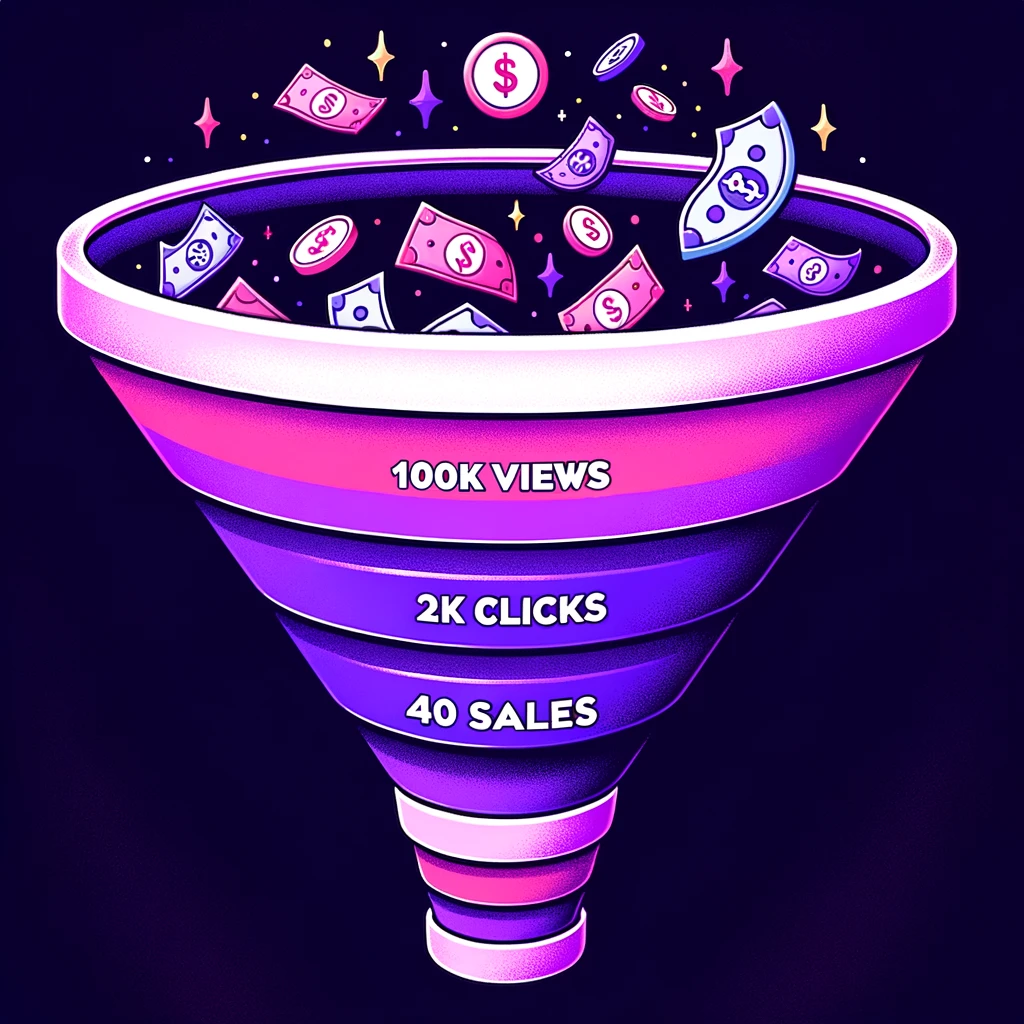From Reach to Revenue: Data-Driven Influencer Partnerships
Go beyond vanity metrics to deliver data-driven, profitable influencer partnerships. Get our actionable insights on conversion funnels, financial metrics, and deal-making.

Hey there, modern marketer. You get it—fluffy metrics don’t drive sales. From understanding your conversion funnel, to leveraging key financial drivers like lifetime value, you want to understand the true ROI potential. Why stop at just reach and clicks when you can factor in estimated acquisition costs, ensuring your influencer partnerships are cost-effective?
This guide cuts through the confusion of social media vanity metrics to deliver actionable, data-driven insights. We'll break down fair price negotiation strategies, share tips for finding audience alignment, and delve into why one-off deals often miss the mark. Think of it as your practical roadmap to influencer partnerships that really pay off, grounded in hard numbers and proven tactics.
Understanding the Conversion Funnel

The essence of influencer marketing is to drive conversions. To truly understand the impact, you must look at the conversion funnel through a quantitative lens. Take, for example, an influencer with an average reach of 100,000 views per post.
Top of the Funnel (Reach): 100,000 views
Reach is the number of impressions on the content, whether it's a video or post.
Middle of the Funnel (Clicks): 2,000 clicks
Clicks are how many people clicked through the sponsored link attached to the content. These are actual visitors on your website and with a 2% clickthrough rate (CTR), you'd have 2,000 clicks.
Bottom of the Funnel (Conversion): 40 sales
From landing on your website to converting into a customer, we'll assume a 2% conversion rate. With those 2,000 clicks, it results in 40 actual sales.
Key Takeaway
Instead of getting swayed by vanity metrics like follower counts, use a detailed, data-driven conversion model. With a reach of 100,000, the funnel might seem wide at the top but narrows down considerably. The result you end up with—40 sales—is a more meaningful metric that directly impacts your bottom line.
Average Order Value (AOV) and Lifetime Value (LTV)
To evaluate the potential ROI of influencer campaigns, we need to zoom in on key financial metrics: Average order value (AOV) and lifetime value (LTV).
- AOV: Let's say your AOV is $100. With the 40 sales from our earlier example, that’s an initial $4000 in revenue.
- LTV: If your customer's LTV is calculated to be $400, those 40 new customers could potentially generate $16,000 over their lifetime with your brand.
Key Takeaway
AOV provides a snapshot of initial ROI, while LTV projects long-term value. Multiply these by the projected sales (40 in our example), and you’ll have a tangible idea of both initial and future revenue expectations.
Negotiating a Fair Price
Price negotiations with influencers are a crucial yet often overlooked aspect. Instead of going in blind and working off their quote, use their estimated reach and CPM (cost per 1k impressions) to calculate a fair price. When we say estimated reach, it shouldn't be based on subscribers or followers, but instead on the performance of their recent content.
Getting a Quote
Begin by asking the influencer for a pricing quote. You can often find their email attached to social profiles or just DM them. Check out our beginner and advanced guides on influencer outreach.


CPM-Based Pricing
With their quote, compare it against industry-standard CPMs. With an estimated reach of 100,000 views, and say a CPM of $8, you can estimate that each post should cost around $800. A good CPM depends on many factors, but it's rare that it should be more than $20 with YouTube long-form content being an exception.
CPA and CAC
Now that you know your estimated conversions (40 sales per post), you can calculate the cost per acquisition (CPA). If a post costs $800 and results in 40 sales, your CPA is $20. Compare this number with your AOV to quickly select which influencers are likely to be profitable, and use it in your negotiations with them to drive a better price.
Key Takeaway
Know your numbers. Your CPA and estimated reach should be your guiding lights in negotiating a fair price. A well-negotiated deal maximizes ROI and ensures both parties get value. It can be great to compare this CPA with numbers that you have from other advertising channels.
Evaluating Audience Alignment

After you've gone through the pricing and estimated CPA, the next step is to validate if the influencer's audience resonates with your brand. Here's how:
- Affiliate Testing: Offer the influencer a promo code or trackable link for a small test campaign. Measure the number of clicks and conversions.
- Past Sponsorship Metrics: Inquire directly about their previous campaigns. How did they perform? What KPIs were achieved? Can they share anonymized success metrics?
- Demographics Deep Dive: Request a breakdown of their audience demographics to see if they match your target market. Some influencers might also share other metrics like watch retention if you ask nicely.
- Audience Behaviour: Examine who engages with the influencer's content. Are they also engaging with brands or content similar to yours?
- Comment Quality: Review comments on the influencer’s posts. Are the people engaged potential customers? Are they asking about product details, or just dropping emojis?
- Competitor Analysis: Keep an eye on which influencers your competitors are engaging with. If those partnerships are fruitful, consider exploring similar avenues.
Key Takeaway
Finding the right influencer is a blend of data-driven tactics and competitor insights. A few smart moves can quickly tell you if there’s a good fit.
The Significance of Multiple Touch Points

In today's saturated market, multiple touch points are often needed to convert a prospect into a customer. In fact, studies show it can take between 6-8 touch points to generate a viable sales lead. So what do we learn from this?
- Frequency and Repetition: A one-off deal with an influencer might generate some buzz, but it’s unlikely to generate sustained sales. It's the repeated exposure that helps in ingraining your brand into the consumer's mind, so find the best influencers and lock them in for a long-term three to six month deal.
- Consistent Messaging Across Touch Points: Ensure that your influencers uses consistent language, offers, and calls-to-action across videos, posts or stories. This coherence strengthens your brand message at every touch point.
- Audience Overlap Matters: One-off deals with influencers whose audiences don’t overlap with your target market can even hurt your company. These might bring in low-quality leads who are less likely to convert, wasting both time and resources.
Key Takeaway
The pathway to conversion isn't a sprint, it’s more of a marathon requiring multiple, frequent touch points. One-off deals and non-overlapping audiences can be more of a hindrance than a help, diluting your brand message and bringing in low-quality leads.
Leveraging Historical ROI for Future Impact

Relying on projections and estimates are a great starting point, but to optimize further you'll need to rely on previous ROI data. The first step is to make sure you're properly tracking your current deals, but there are some creative ways to access even more insights in where you can get the best returns.
- Your Own ROI History: If you've run influencer campaigns before, make sure you've really dug into those analytics. Look at metrics like customer acquisition cost, conversion rates, and customer lifetime value to establish your baselines and you'll often learn something you didn't see before.
- Industry Benchmarks: Although hard to come by, reaching out to agencies, influencer marketing managers, or even influencers can sometimes yield valuable performance data that can serve as a useful benchmark.
- The Network Effect: Connect with other professionals in your industry, perhaps through LinkedIn or Slack communities. People are more likely to share insights on a peer-to-peer level.
- Influencer Transparency: Some influencers are open to sharing their past performance metrics, especially if they believe in the potential synergy with your brand. Don't hesitate to ask during your vetting process.
- Value Over Vanity: When you do get your hands on this goldmine of data, focus on ROI-driving metrics over vanity metrics. An influencer with a smaller but more engaged and converting audience can often offer a better ROI than one with massive but passive followers.
Key Takeaway
Past data is a useful way to make good predictions. By arming yourself with historical ROI data, either your own or industry benchmarks, you can more accurately forecast an influencer's future impact, thereby making more informed, and profitable, decisions.
Will My Influencers Generate Sales and Profit?
You've parsed the data, reviewed the metrics, but what's left is the big question: will this influencer move the needle for your sales?
Example: Making Sense of It All

Let's say you're sponsoring 12 pieces of content through brand deals. Each is expected to bring in about 100,000 views. With a CPM of $8, each piece of content will cost you $800, totalling $9,600 for all 12.
- Click-Through and Conversions: With a 2% clickthrough rate on 100,000 views, you're looking at 2,000 clicks per content piece. A 2% conversion rate from there gives you 40 sales for each, or 480 in total.
- Revenue: With an average order value of $100, you'd earn $48,000 initially. Factor in a lifetime value of $400 per customer, and you're potentially looking at $192,000 in the long run.
- CPA: Your total investment is $9,600. With 480 conversions, your cost per acquisition sits at a neat $20.
- Audience Fit: We made sure that the influencers' audiences have strong overlap with our target customer's demographics. Aiming for our 12 pieces to get our 6-8 touch points with some potential customers.
Takeaway and Your Next Move
Here's the upshot: you invest $9,600 and, based on these metrics, could see an initial return of $48,000 with a long-term potential of $192,000. That's a 5x ROAS in the short term and up to 20x considering the LTV. All with a strong CPA of $20.
So, with this approach you're not just hoping for the best—you're strategically positioned for a win.
Looking to make this process even smoother? Dreamwell AI is here to prevent influencers from underperforming or overcharging, which results in brands lowering costs and increasing revenue. Request a demo to get started. Tell us you came from this article and we'll be sure to give you a great offer.

